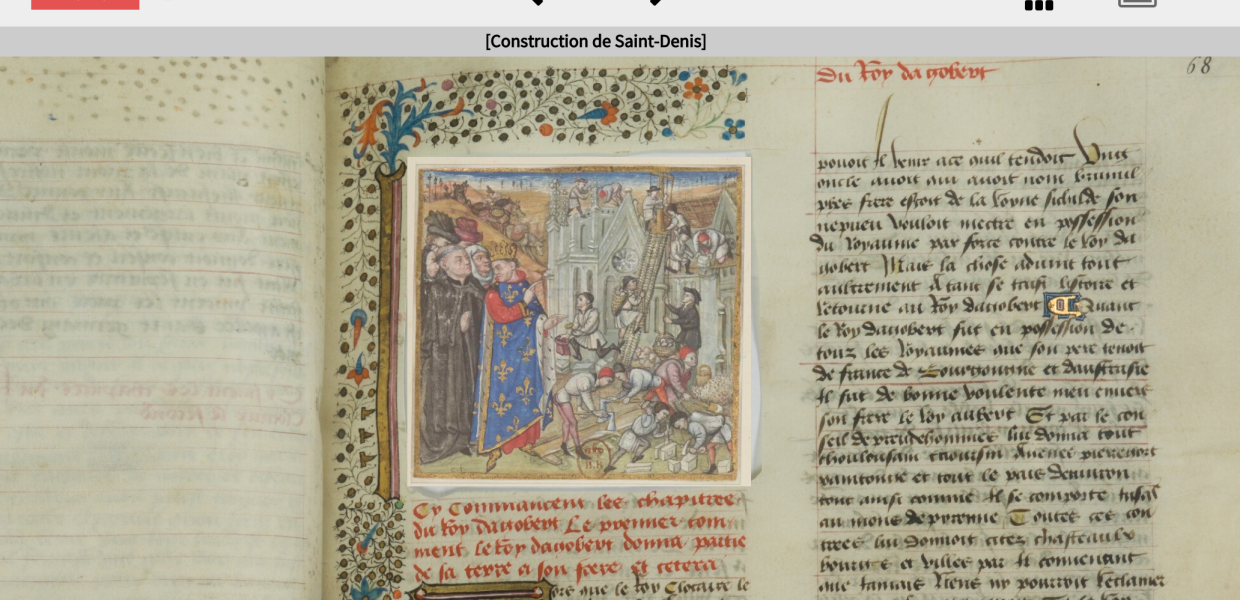Europeana aligns with the International Image Interoperability Framework (IIIF)
Discover how Europeana hopes to promote the adoption of the IIIF technology by demonstrating its value and, from a more technical perspective, by making Europeana's own technical stack more interoperable with IIIF implementation initiatives.

- Title:
- IIIF in action: in this screenshot from a Biblissima project demos, the illumination comes from the BnF's Département des Estampes, while the mutilated manuscript belongs to a different collection - that of the Bibliothèque municipale de Châteauroux. Image: CC-BY Biblissima project
One of Europeana's main goals is to make it easier for institutions and individuals in the digital heritage sector to share better quality digital content - you can learn more in our recently published Europeana Publishing Framework.
The International Image Interoperability Framework (IIIF) has huge potential to help us achieve this goal. If you’re not familiar with it, IIIF is a standard for serving and consuming high quality images online, with the ability to instruct a server about the desired resolution, or image manipulations such as rotation and zooming. It also makes it more straightforward to publish complex aggregations of images, for instance bringing together a medieval manuscript text and an illumination that was stripped away from it.
Europeana hopes to promote the adoption of the IIIF technology by demonstrating its value and, from a more technical perspective, by making Europeana's own technical stack (including the Europeana Data Model and the Europeana Collections portal) more interoperable with IIIF implementation initiatives.
Europeana's David Haskiya talked more about this at the recent IIIF Conference ‘Access the world's images’, a day that has been covered in detail by our friends at Sound and Vision in another blog post. David's slides can be accessed in the presentation folder for the event.
But that wasn’t all that was IIIF-related in Ghent that week: a series of other, more detailed meetings also took place, and again, Europeana played an active role. If you’d like to know more about these, there are minutes available for the different parts:
- a community roundtable and more demos and lightning talks, working on priorities ahead for the IIIF community
- an unconference, where we began to dive deeper into some of the selected issues
- a specific session on IIIF and Newspapers, co-chaired by Karen Estlund from Penn State University and Europeana's Alastair Dunning.
Alongside these, many other informal discussions took place. An important one for us focused on the issue of how Europeana data providers could better reference IIIF resources in the EDM metadata they send to us, and this has been captured on IIIF's issue discussion space on Github. As with many breakthrough discussions, intensive use of diagrams (and, to a smaller extent, drinks!) helped different experts reach a satisfying consensus.

Sketch model from a discussion on EDM and IIIF at IIIF Ghent meeting. Glen Robson, CC BY
Several week later, and we have now published a deliverable from the Europeana Cloud project (available here) that fully documents the data exchange problems and modelling options we discussed during and around the Ghent events. Europeana Cloud provided an excellent context for better aligning Europeana with IIIF as it brought together providers of IIIF images and aims to develop IIIF services for the Europeana environment.
The deliverable, Recommendations for enhancing EDM for representing digital content, proposes data modelling solutions for representing digital objects (such as images) and full-text with a particular focus on Newspapers resources.
This work was based on case studies from the Vrije Universiteit Amsterdam Library and the Welsh Newspapers from the National Library of Wales. In this report we first propose modelling solutions to link a cultural heritage object (CHO) to its digital representation(s). In this context, a particular focus is put on the interoperability with the IIIF protocol, as more and more Europeana Network members have adopted it or are thinking about adopting it.
We decided to align EDM to the solutions defined by the IIIF community and therefore extend EDM with the required classes and properties. A similar approach was taken for proposing solutions to represent full text. In order to maximise interoperability with ongoing efforts in other communities we decided to follow the data modelling solutions from both the Web Annotation Data Model and the IIIF protocol. We therefore propose to model full-text in EDM as an annotation on a given digital representations.
All these data modelling proposals will have to be further discussed and validated by the IIIF and the Web Annotation communities. We also hope that the collection of new cases studies will help us further explore the challenges offered by full-text resources.
If you are interested in contributing to these efforts, please let us know by contacting us.
